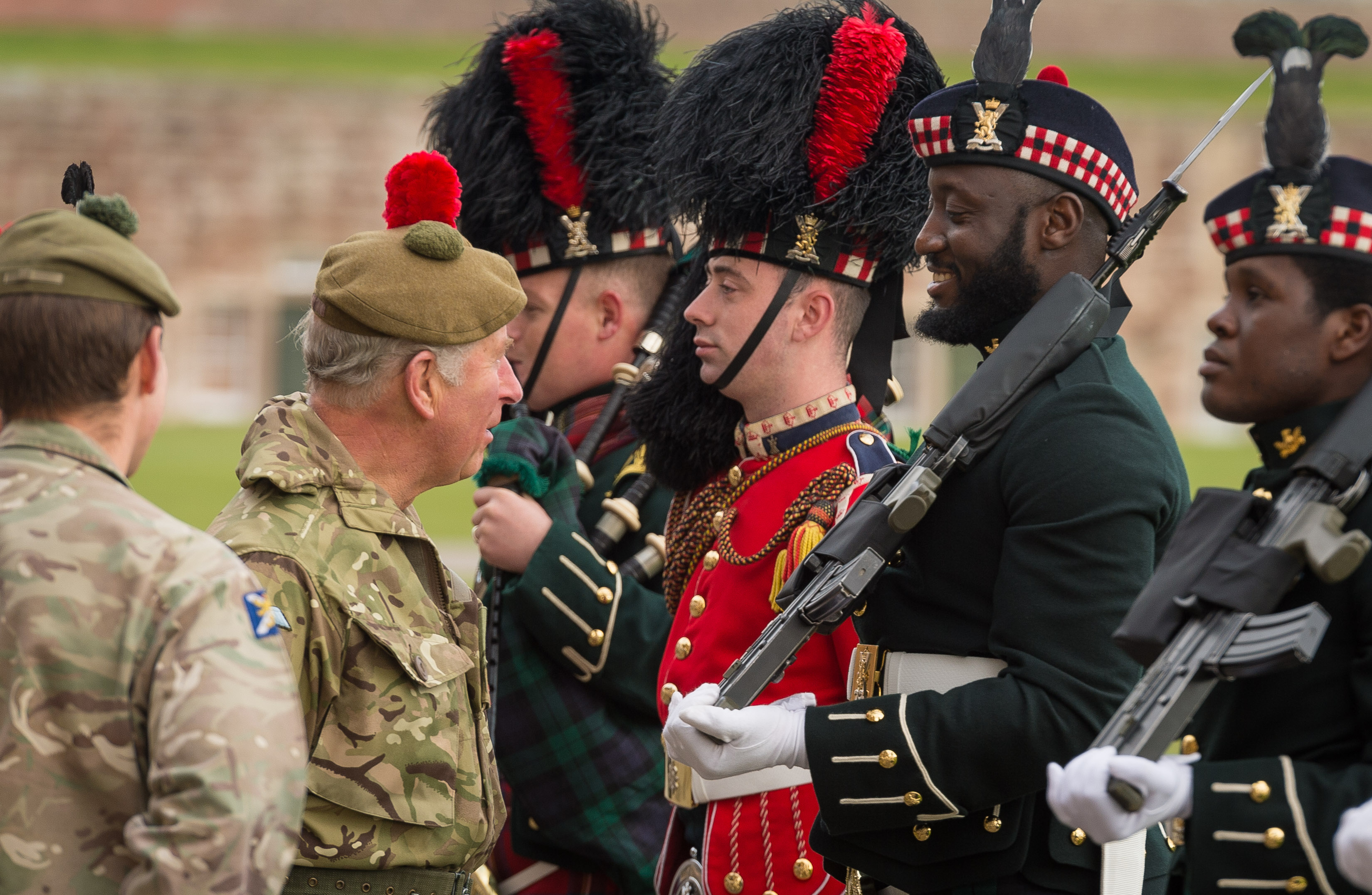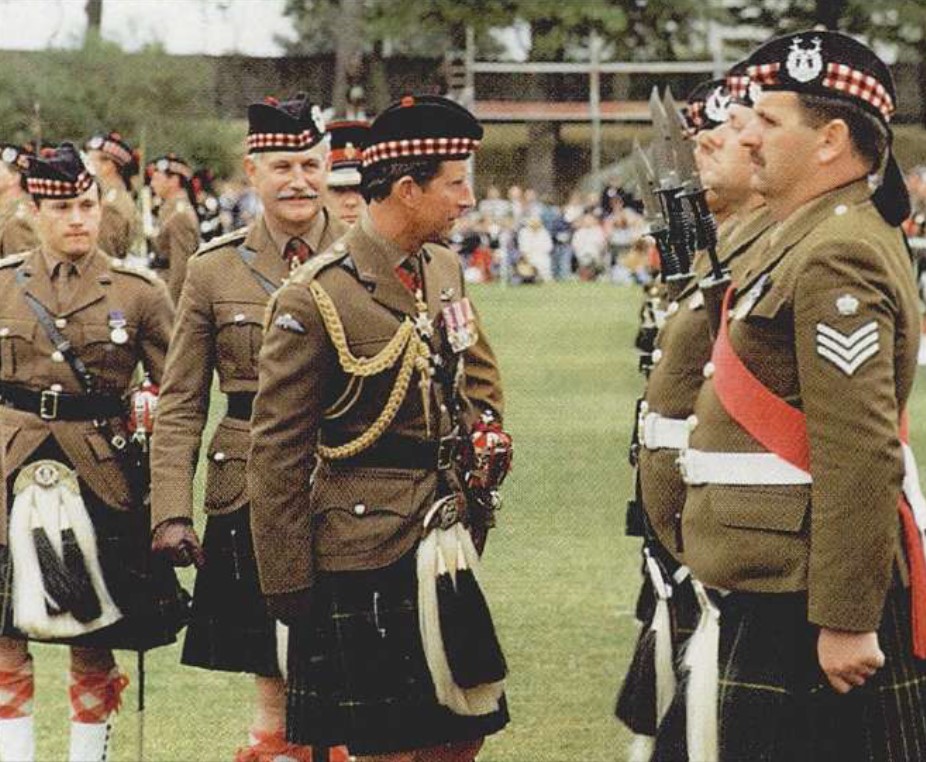Behind the pomp and circumstance of the Coronation of Their Majesties King Charles III and Queen Camilla on Saturday 6 May 2023 lies the wonderful connection between His Majesty to the Army in Scotland.
The King’s ties link back to 1977 when he became Colonel-in-Chief of the then Gordon Highlanders. This is an appointment held until 1994 when he became Deputy Colonel-in-Chief of the Highlanders (Seaforth, Gordons and Camerons).
In 1983, as Colonel-in-Chief of the Gordons he, in discussion with the Colonel of the Regiment and Commanding Officer, wanted to present a ‘Dirk’ (dagger) to the winner of the annual inter-platoon patrols competition.
This was a series of military and novel testing stands at intervals along a patrols route of many miles which was to be completed successfully in the fastest time. The results of this were added to the scoring (accumulative points) at the testing stands and kit inspection to identify the best all round Platoon. This was named the Duke of Rothesay’s Dirk Competition and is still competed for annually by the platoons of 4 SCOTS.
His Majesty’s visits were always enjoyed by all ranks, and he had a fantastic rapport with the ‘Jocks’ and he was especially proud of the Regiment Lieutenant Colonel (Retired) Brian Ross MBE
As Deputy Colonel-in-Chief of the Highlanders, the Regiment sadly did not see much of His Majesty, as his father, The Duke of Edinburgh as Colonel-in-Chief, attended most Highlander and subsequently 4 SCOTS events.
Lieutenant Colonel (Lt Col) (Retired) Brian Ross MBE was a Regimental Sergeant Major of the Queens Own Highlanders and subsequently a commissioned Late Entry officer in The Highlanders for many years during His Majesty’s time as Deputy Colonel-in-Chief.
His Majesty attend the Colours Parade with Prince Phillip at Redford Barracks in 2001 for the Presentation of the New Colours to The Highlanders (the only set they received) which are now laid up in the Scottish National War Memorial in Edinburgh Castle. His Majesty also visited the Regiment regularly.
Lt Col (Retd) Ross recalls: “His Majesty’s visits were always enjoyed by all ranks, and he had a fantastic rapport with the ‘Jocks’ and he was especially proud of the Regiment.”
When the Queen Mother died, His Majesty relinquished his Deputy Colonel-in-Chief role and assumed the Colonel-in-Chief appointment of the Black Watch – which was felt as a sad loss by many in the Highlanders.
It is understood that The King made it noticeably clear of his fondness for the Regiment, which it is said he strongly regarded as ‘my Regiment’.
On the amalgamation of The Black Watch (Royal Highland Regiment) in 2006 into The Royal Regiment of Scotland, in his capacity as The Duke of Rothesay he became Royal Colonel of the 3rd and 7th Battalions (3 SCOTS and 7 SCOTS).
His Majesty was, and still is, an extremely popular Royal Colonel.
Ronnie Proctor, who has served in the unit and afterwards actively in the Regimental Association for a total of 63 years, recalls many instances with the then Duke of Rothesay.
One instance in particular: “The Powrie Brae statue, near Dundee, of a Black Watch soldier marks the previous line between the 4th and 5th Battalions. This needed being refurbished. David McMicking, had asked whether His Majesty would be able to attend and the Equerry at the time had replied saying no. However, when His Majesty found out, was not impressed, and drove himself in a Land Rover from Birkhall to the Powrie Brae.” The refurbishment unveiling went from being very low-key to a very high-key event immediately with His Majesty being received formally afterwards at the Dundee City Chambers.”
Here, Ronnie Proctor introduced His Majesty to ‘May-May’ Bruce-Jardine whose father had served in the Black Watch with Fergus Bowes-Lyon. Fergus was the Queen Mother’s late brother who was killed at the Hohenzollern Redoubt during World War I and in memory of whom was the reason for her having become our Colonel-in-Chief.
In recent years, at Forfar, the Black Watch Regiment was exercising its right to the Freedom of Forfar by marching through.
Ronnie Proctor, as Provost, had organised for some Perth and Dundee Association members, regimental personalities, to meet the then still Duke at the British Legion club.
There are so many fond memories of The King and Major (Retired) TJO Carmichael commented: “Matters like this can’t be undone, broken or shattered; there’s a warmth from across all-ranks towards His Majesty which will always prove the respect in which he is held, because he and his family have been there for us.”
In 2006 His Majesty, as The Duke of Rothesay, became Royal Colonel of the 3rd Battalion, The Royal Regiment of Scotland (3 SCOTS) and the 7th Battalion (7 SCOTS). When The Royal Regiment of Scotland formed, all the antecedent Colonels-in-Chiefs were re-titled Royal Colonels of the new battalions, and the late HM Queen Elizabeth became Colonel-in-Chief of the newly formed Regiment.
The Duke of Rothesay is the title mandated for use by the heir apparent when in Scotland, the title being named after Rothesay on the Isle of Bute. The Duke of Rothesay also holds other Scottish titles, including those of Earl of Carrick, Baron of Renfrew, Lord of the Isles, and Prince and Great Steward of Scotland. HM The King held the Duke of Rothsay title since 1952 until the death of HM Queen Elizabeth.
Since 2006, The Duke of Rothesay has conducted several royal visits to 3 SCOTS including Palace Barracks in Northern Ireland, Public Duties in Edinburgh and in 2018 Fort George, Inverness where he presented the Maxwell Shield (for champion company) to Delta (Light) Company.
As Duke of Rothesay, His Majesty maintained his link with the Gordons as Patron of The Gordon Highlanders Museum in Aberdeen.




